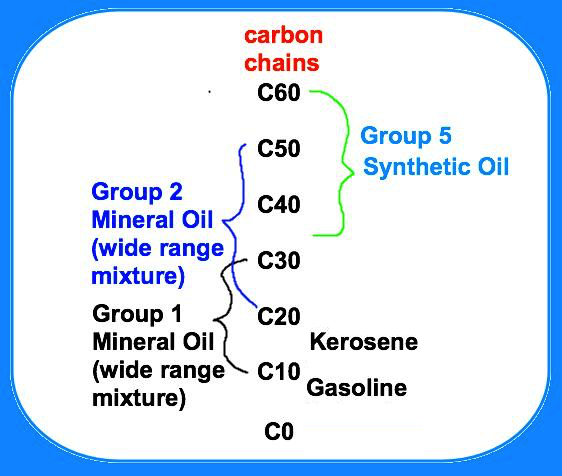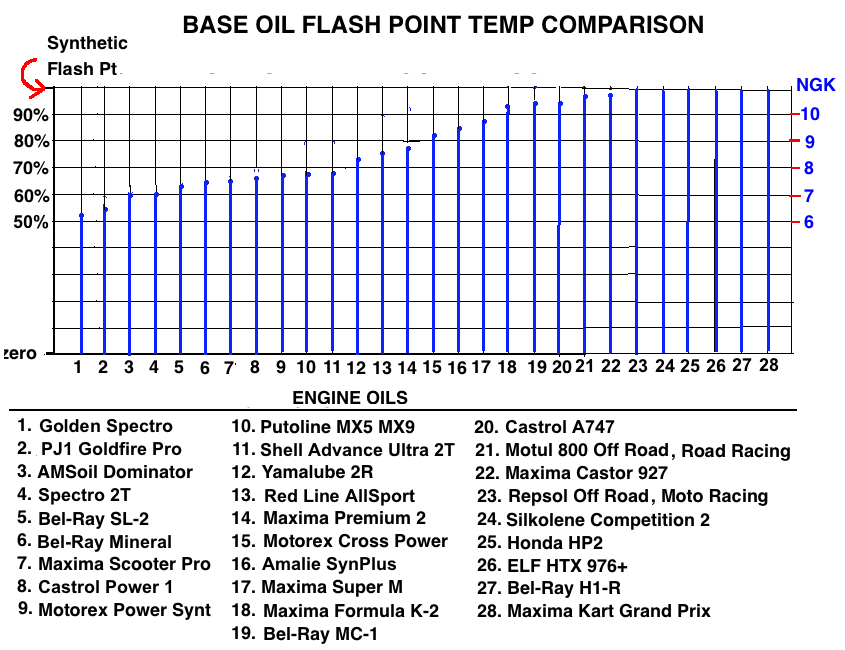| Engine Oil Combustibility If we consider oils flamability as related to their average carbon chain lengths (how many carbon atoms are in each molecule) then we can apply that to engine oils to rate them from 0 to 1.0 signifying zero flamability to being as flamable as gasoline (average of 8 carbon chains). Most engine oils are made of synthetic oil and group 1 mineral oil. What is unknown but that can be discovered thru testing is where castor oil falls in this range.  Why This Is Significant It's been noticed that larger jets are needed when switching from a mostly mineral oil product to a mostly synthetic oil product. So this is because the mineral oils contribute much more to the combustion in the cylinder than synthetic oils do. That is one reason they smoke more because of burning and why synthetic oils smoke less and make more spooge, because they are more resistant to burning. So if oils can contribute to combustion then they can probably affect burn rate which affects when peak combustion heat/pressure happens which affects what ignition timing and squish velocity is needed. Also if you speed up the combustion then you can relieve some of the compression with a head with more volume. Engine oils are part of the overall formula, just as type of gasoline is. Its Affect On Power Maybe the difference isn't large but I'd say that this could be important to racers as well as anyone wanting to switch oils without having to redo their jetting. Racers are always after the very smallest of gains because they all add up. OILS PROTECTIVENESS But of primary importance is choosing an oil that is protective enough. Oils with at least 50% castor oil protect everything but the semi-synthetics have different ratings depending on the average flash point temperature of all the oils in the product. This isn't the products listed flash point which is often lowered due to added kerosene. Click here for the full explanation. This graphic recommends engine oils based on engine heat which is reflected by the NGK heat range of the spark plug you use. So from the list of oils that are above your heat range line (look at right side of graph) you can choose one that has the best combustibility rating so you don't use an oil with too much synthetic in it.  Oils that didn't list enough info for me to make an estimate of their flash point averages were: Motul 510, Motul 710, Motul Scooter Expert, Amsoil Interceptor, Lucas Semi-Synthetic. Rating Oils Combustibility Looking at the top graphic you can see the range of carbon chains that each oil group has. I've averaged the ranges together for each group to have one representative # for each group although I skewed synthetics up to 55 because most synthetics are close to 60. Then using the % of each oil group in each product as is detailed in their safety data sheets I came up with the rating from 0 to 1.0, with 1.0 being the combustibility of gasoline. My oils page lists the percentages also of the different types of oils in each product. The result of this rating system was that all the mineral oils and semi-synthetics ranged from 0.21 to 0.28, and the fully synthetics were 0.15 which is about half as combustible. So you'll only experience a change when going to or from fully synthetic. My oils page lets you see which ones are fully synthetic. Many products are touted to be so in their promotional literature although they aren't. Synthetic/Castor Oils: Silkolene Pro KR2, Penrite 10 Tenths Race Castor, Maxima CASTOR 927 Fully Synthetic Oils: Maxima Super M, Bel-Ray H1-R, Silkolene Comp 2 Plus, Silkolene Pro 2, Maxima FORMULA K-2 (7.5% mineral oil), Castrol Power1 XR 77, Motul 800 2T Off Road and Road Racing (6% mineral oil), Klotz R-50 Techniplate, Honda Pro Honda HP2, Motul Kart Grand Prix, ELF HTX 976+, Repsol Moto Racing 2T (most other oils that say or imply they are fully synthetic aren't. This is knowable if you know how to interpret their safety data sheets) Fuel to Oil Ratio This depends mostly on the products viscosity at upper cylinder temperature. The higher the temp, the lower the viscosity becomes. Factors affecting engine heat are mostly type engine cooling and max RPM. Oils only have their 40*C and 100*C viscosities listed although engines typically are somewhere between 150*C and 200*C. This makes it impossible to guess what ratio is needed which is why I created a fuel/oil Ratio Calculator that estimates the upper cylinder temp and the oil viscosity at that temp and then recommends a ratio based on those calculations. Check it out as well as my other 2 stroke calculators at this page. |